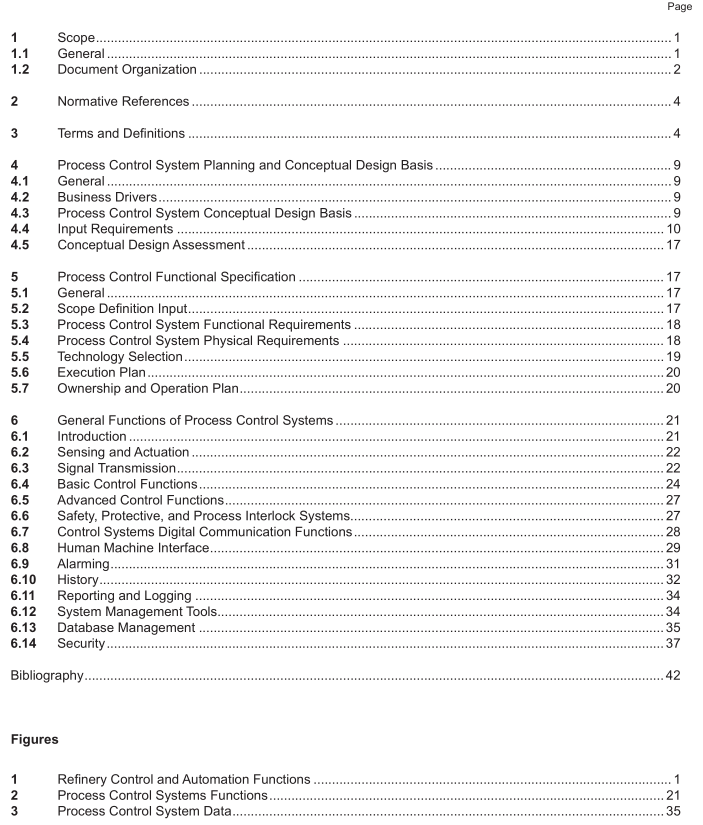API RP 554-1 pdf download

API RP 554-1 pdf download Process Control Systems— Functions and Functional Specifcation Development
2Normative References
The following documents are referred to in the text in such a way that some or all of their content constitutesrequirements of this document. For dated references, only the edition cited applies. For undated references, thelatest edition of the referenced document (including any addenda) applies.
API Recommended Practice 552,Transmission Systems
3 Terms and Definitions
The following terms and definitions are used in this document.Additional definitions are provided in Parts 2 and3 when necessary to support the content of those documents.
3.1
batch control
Control functions that occur in a series of complex steps or phases that may combine continuous control,sequence control, and discrete control to execute a processing scheme.
3.2
business network
A digital communications network that is used for general purpose business use such as desktop computing,non-process control database applications or other general purpose applications. Can be referred to as Purduelevel 4.Typically, business networks use industry standard communications methods such as Ethernet.
3.3
central control roomccR
Inhabited facility (typically a building) that houses plant personnel and PCS equipment to permit the operationand coordination of one or more process plants.Control rooms are not always located adjacent to the processequipment being controlled and often centralize operation of multiple process plants or areas.Trends are tolocate control centers away from potential blast zones.
3.4
continuous control
Control functions that are continuously and repetitively executed to control the values of process variables suchas pressure, temperature, flow, etc. that are part of a continuous process such as a refining process, or within aportion of a process associated with a batch control system.
3.5
control loop
That part of an instrument control system that includes the input sensor, transmitter,communication path, controlalgorithm, and final control element Control algorithm may be executed as one of many such algorithms in aPCs or be performed by stand-alone electronic, pneumatic, or mechanical devices.
3.6
control module
A processing module that performs various control and data acquisition functions in a PCS. Typically,thismodule is used to poll data from system l/O modules, perform basic regulatory or other control functions,andcommunicate lO and control information to other modules in the PCS.
3.7
demilitarized zoneDMz
A physical or logical subnetwork that contains and exposes an organization’s external-facing network servicesto a larger and untrusted network,i.e. the organization’s business local area network (LAN) or the Internet.The purpose of a DMZ is to add an additional layer of security to an organization’s LAN, by isolating externalcommunications to the process control network.
3.8
discrete control
Control functions that involve on-off operations and interlocks. Discrete control variables are generally associatedwith thresholds above or below which a control action is taken. The control action is a discrete function such asopening or closing a valve, starting or stopping a motor, etc.
3.9
distributed control systemDcs
A general term used for digital PCSs that use multiple processing modules to perform the functional tasks of thesystem.These modules may or may not be located in physical proximity to one another.
3.10
encryption
The coding and decoding of data transmissions using algorithms and encryption keys that are known only to thesending and receiving devices. A wide variety of encryption techniques and algorithms are available and havevarying levels of security associated with them.
3.11
enterprise resource planningERP
Systems that are used to identify and coordinate supplies of raw materials,intermediate materials, finishedproducts, consumables,and other material or resources required to operate a manufacturing business.
3.12
Ethernet
A networking standard that is either wireless or uses a single cable consisting of four pairs of wires to connectmultiple computing devices together in a manner that does not require that any of the devices be aware of the otherdevices. Ethernet is an asynchronous communications method that allows messages to collide and provides fora collision detection and a random pause and retry means of allowing multiple devices to communicate.Ethernetstandards are defined in the lEEE 1802.x series of standards.
3.13
fieldbus
A digital communication network that connects the field sensors, transmitters, and control actuators together andto either a controller or control network. A field bus network allows devices to send and receive messages overa shared path. Devices may send current measurements and/or diagnostic messages and receive commandsor configuration data.









